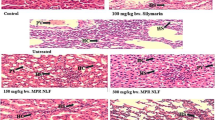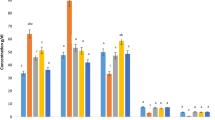Abstract
Heavy metal pollution is a global public health challenge due to its stable and persistent environmental contamination. Of these lead is considered to be one of the most common ubiquitous and industrial pollutants and at low concentration it exerts extensive damages to the tissues. Daily feeding of lead acetate solution (Dose: 10 mg/kg/day) to normal rats for a month adversely altered the parameters of blood, serum and tissues, viz; RBC, WBC, Hb, ɗ- ALAD (Delta amino levulinic acid dehydratase), Pb content, lipids, oxidized lipids (TBARS), vitamins C and E and GSH levels and activities of AST, ALT and antioxidant enzymes viz; catalase, GR, Gpx and SOD. In order to study whether antioxidants have any effect to counteract the toxicity of lead we have selected comparatively better active allium fractions for the study viz: polar fraction of garlic (PFG) and polar fraction of onion (PFO). On feeding of these active fractions of garlic and onion oils i.e. their polar fractions and vitamin E (Dose 100 mg/kg/day) separately for a month along with or without lead acetate to rats each nutraceutical and vitamin E counteracted the adverse effects of Pb significantly (p ≤ 0.05). Their effects are in the order of PFG > PFO > Vitamin E. All these results point out that garlic and onion oils contain natural disulfoxide compounds which act as antioxidant and anti toxic to lead compounds. Their comparative differences in action may be due to the presence and position of double bonds and disulfide oxide bonds in their molecules. i.e., in PFG the allyl disulfide oxide group is present and in PFO saturated methyl and propyl groups and unsaturated propenyl group are present in place of allyl groups. The former group confers a better antioxidant activity on PFG, while the latter groups confer a lesser activity on PFO.






Similar content being viewed by others
References
Mohod VC, Dhote J. Review of heavy metals in drinking water and their effects on human health. Int J Innov Res Sci. 2013;2:2992–6.
Mudgal V, Madaan N, Mudgal A, Singh RB, Mishra S. Effects of toxic metals on human health. Open Nutraceuticals J. 2010;3:94–9.
Neal AP, Gullarte TR. Mechanisms of heavy metal neurotoxicity: lead and Manganese. J Drug Metab Toxicol. 2012;S5:1–13.
Flora SJS, Mittal M, Mehta A. Heavy metal induced oxidative stress and its possible reversal by chelation therapy. Indian J Med Res. 2008;128:501–23.
Fulendra S, Senthil Kumar M, Mahadevan N. Nutraceuticals: uplift in health. Int J Recent Adv in Pharm Res. 2012;2(2):17–28.
Tikare NS, Yendigeri S, Gupta AD, Dhundasi SA, Das KK. Effect of garlic (Allium Sativum) on hematology and erythrocyte antioxidant defense system of albino rats exposed to heavy metals (nickel II and chromium VI). Ind J Physiol Pharmacol. 2012;56(2):137–46.
Sajitha GR, Jose R, Andrews A, Ajantha KG, Augustine P, Augusti KT. Garlic oil and vitamin E prevent the adverse effects of lead acetate and ethanol separately as well as in combination in the drinking water of rats. Ind J Clin Biochem. 2010;25(3):280–8.
Mathew PT, Augusti KT. Hypoglycemic effects of onion, Allium Cepa L on diabetes mellitus a preliminary report. Ind J Physiol Pharmacol. 1975;19(4):213–7.
Harishekar MB. Studies on alcohol-lead interactive hepatotoxicity. Ph.D.Thesis (submitted), Rajiv Gandhi University of Health Sciences Bangalore, Karnataka. 2003. pp. 77–97.
Augusti KT. Gas chromatographic analyses of onion principles and a study on their hypoglycemic action. Indian J Exp Biol. 1976;14:110–2.
Lukes TM. Thin-layer chromatography of cysteine derivatives of onion flavor compounds and the lacrimatory factor. J Fd Sci. 1971;36:662–4.
Johnson AE, Nurston HE, Williams AA. Vegetable volatiles: a survey of components identified. Chem Ind (Lond). 1971;556–65, 1212–24.
Temple KH. Effect of garlic on experimental cholesterol atherosclerosis in rabbits. Medzin Ernahr. 1962;3:197–9.
Beers RF, Sizer IW. A spectrophotometric method for measuring the breakdown of hydrogen peroxide by catalase. J Biol chem. 1952;195:133–40.
Misra HP, Fridovich I. The role of super oxide anion in the auto oxidation of epinephrine and a simple assay for superoxide dismutase. J Biol Chem. 1972;247:3170–5.
Paglia DE, Valentine WN. Studies on the quantitative and qualitative characterization of erythrocyte glutathione peroxidase. J Lab Clin Med. 1967;70:168–9.
Pinto DE, Bartley W. The effect of age and sex on glutathione reductase and glutathione peroxidase activities on aerobic glutathione oxidation in rat liver homogenate. Biochem J. 1969;12(7):109.
Jain SK, Mc Vie R, Duett J, Herbst JJ. Erythrocyte membrane lipid peroxidation and glycosylated hemoglobin in diabetes. Diabetes. 1989;38:1539–42.
Beutler E, Duron O, Kelly BM. Improved method for the determination of blood glutathione. I Lab Clin Med. 1963;61:882–8.
Mc Gowan MW, Artin JD, Zak B. A peroxidase coupled method for the colorimetric determination of triglycerides. Clin Chem. 1983;29:538–42.
Allain CC, Poon LS, Chan CS, Richmond W, Fu Pc. Enzymatic determination of total serum cholesterol. Clin Chem. 1974;20:470–5.
Lopes virella MF, Stone P, Ellis S, Colwell JA. Cholesterol determination in high density lipoproteins separated by three different methods. Clin them. 1977;23:882–4.
Frield wald WT, Levy RS, Friedricks en DS. Estimation of concentration of low density lipoprotein cholesterol in plasma without rise of preparative ultracentrifuge. Clin Chem. 1972;18:499–502.
Baker H, Frank D, Winley NC. Clin Vitam. 1968;772.
Tietz NW. Text book of clinical chemistry. Philadelphia: W.B saunders company; 1986. p. 960–2.
Lowry OH, Rosebrough NJ, Farr AL, Randall RJ. Protein measurement with folin phenol reagent. J Biol chem. 1951;193:265–75.
Tandon SK, Singh S, Prasad S. Influence of garlic on the disposition and toxicity of lead and cadmium in the rat. Pharm Biol. 2001;39(6):450–4.
Augusti KT, Anuradha Prabha SP, et al. Nutraceutical effects of garlic oil, its non polar fraction and a Ficus flavanoid as compared to vitamin E in CCl4 induced liver damage in rats. Indian J Exp Biol. 2005;43:437.
Helen A, Krishnakumar K, Vijayammal PL, Augusti KT. Antioxidant effect of onion oil (Allium cepa L) on the damages induced by nicotine in rats as compared to alpha –tocopherol. Toxicol Lett. 2000;116:61–8.
Terayama K, Maehara N, Maratsugu M, et al. Effect of lead on electrophorectic mobility of rat erythrocytes. Toxicol. 1986;40:259–65.
Mostafa MH, Osfor MM, Ibrahim HS, Mohamed YA, Ahmed SM, Abd El Azeem AS, Hegazy AM. Effect of alpha lipoic acid and vitamin E on heavy metals intoxication in male albino rats. J Am Sci. 2010;6(8):56–63.
Gurer H, Ozgunes N, Neal R, et al. Antioxidant effects of N-acetyl cysteine and succimer in red blood cells from lead exposed rats. Toxicol. 1998;128:181–9.
Masci O, Carelli G, Vinci F, et al. Blood lead concentration and biological effects in workers exposed to very low lead levels. J Occup Environ Med. 1998;40:886–94.
Baranowska-Bosiacka I, Hlynczak AJ, Machalinski B. The impact of lead ions on metabolism of erythrocytes. Med Pr. 2000;51:59–65.
Abd EI Rohiem A, Yassin MM, Nahed M, Rokaya M. Blood, serum glucose and renal parameters in lead load albino rats and treatment with some chelating agents and natural oils. Turk J Biol. 2007;31:25–34.
Attia MH, Ali SH. Natural compounds as anti lead active substances. Egypt J Medl Sci. 1993;14:327–34.
Hanafy MS, Shalaby SM, el-Fouly MA, et al. Effect of garlic on lead contents in chicken tissues. Dtsch Tierarztl Wochenschr. 1994;101:157–8.
Augusti KT. Gas chromatographic analysis of onion principles and a study on their hypoglycaemic action. Ind J Exp Biol. 1976;14:110–27.
Nautila AM, Puupponen-pimia R, Aarni M, Oksman-calentey K-M. Comparison of antioxidant activities of onion and garlic extracts by inhibition of lipid peroxidation and radical scavenging activity. Food chemistry. 2003;81:485–93.
Ashour MN, Megahed HA, Morsy SM, Eltoukhy SI, Youness ER. Antioxidant and radical scavenging properties of garlic oil in streptozotocin induced diabetic rats. Aust J Basic Appl Sci. 2011;5(10):280–6.
Dawoud FH, Hanaa A, WafaiMetwally MAA. Effects of garlic (Allium sativum) on some heavy metal (copper and zinc) induced alteration in serum lipid profile of oreochromis niloticus. World J Fish marine sci. 2009;1(1):1–6.
Gebhardt R. Inhibition of cholesterol biosynthesis by a water soluble garlic extract in primary cultures of rat hepatocytes. Arzneimitltel forschung. 1991;41:800–4.
Gebhardt R, Beck H. Differential inhibition, effects of garlic – derived organo sulfur compounds on cholesterol biosynthesis in primary rat hepatocyte culture. Lipids. 1996;1:269–76.
Petkov V, Stoev V, Bukalov D, Petov L. The Bulgarian drug satlal as a remedy for lead intoxication in industrial conditions. Higiena Trinda I Profesionaline Zabolevania. 1965;9(4):42.
Augusti KT, Anuradha SP, Prabha KB, Smitha M. Sudheesh, Anu George and M.C Joseph. Neutraceutical effects of garlic oil, its non polar fraction and a ficus flavanoids as compared to vitamin E in CCl4 induced liver damage in rats. Indian. J Exp Biol. 2005;43:437–44.
Klans-Dieter A. Sulfur content free radicals. In: Nygaard OF, Simic MG, editors. Radio protectors and anti carcinogens. Newyork: Newyork Academic press; 1980. p. 23–42.
Burton GW, Ingold KW, Vitamin E. Application of the principles of physical organic chemistry to the exploration of its structure and function. Acc Chem Res. 1986;19:194–226.
Acknowledgments
We acknowledge with thanks Prof. Sathya Sudha Devi head of the department of biochemistry and the management of Sreemookambika Medical College, Kulasekharam, Kanyakumari (Dist), TN for giving me the facilities for doing the animal experiments and laboratory analysis.
Author information
Authors and Affiliations
Corresponding author
Ethics declarations
Conflict of Interest
G. R. Sajitha, K. T. Augusti, Regi Jose declare that they have no conflict of interest.
Ethical approval
“All applicable international, national, and/or institutional guidelines for the care and use of animals were followed.”
Rights and permissions
About this article
Cite this article
Sajitha, G.R., Augusti, K.T. & Jose, R. Prophylactic Effects of Garlic Oil and Onion Oil Fractions as Compared to Vitamin E on Rats Orally Fed with Lead Acetate Solution. Ind J Clin Biochem 31, 260–269 (2016). https://doi.org/10.1007/s12291-015-0526-9
Received:
Accepted:
Published:
Issue Date:
DOI: https://doi.org/10.1007/s12291-015-0526-9




